Best triathlon bike shoes in 2024 reviewed
As well as a good fit and a stiff sole, triathletes also need bike shoes that are easy to get on and off in a hurry. Jack Sexty and James Witts test 14 of the best triathlon bike shoes to see which ones tick all the boxes...
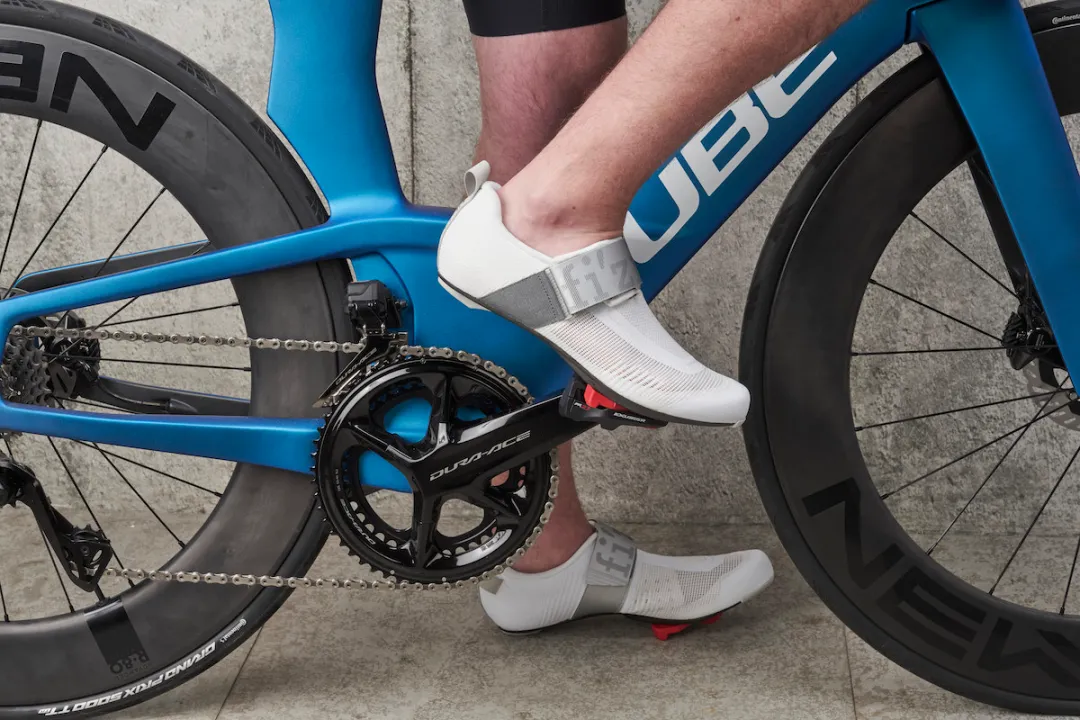
Is it worth investing in triathlon bike shoes, or can road shoes do the job?
Well, there are plenty of reasons to purchase triathlon bike shoes, even if you aren’t going to perform a perfect flying mount any time soon.
Firstly, triathlon bike shoes are often better ventilated. This is useful if you’re racing in the heat of summer and want to stay cool from head to toe before dismounting and taking on a sweltering run.
Quality triathlon bike shoes will also have strategically placed mesh and even technology that helps the shoe dry quickly when mounting your bike after the swim.
Road shoes aren’t really designed to dry from the inside and you don’t want to risk having soggy feet and shoes for the entire bike leg.
Of course, if you’re looking to shave seconds off your transition, then you’ll be interested in the classic triathlon shoe features, including: a wider opening for getting your feet in, heel loops to pull your shoes on and off, and venting holes in the sole for breathability.
As you’ll see, a Boa ratchet is an increasingly popular method. You’ll also witness that many triathlon bike shoes employ reverse main straps, which run the opposite way to traditional road numbers.
Though, the downside of triathlon straps is that they can catch on the crank if they’re too long.
See our full buying guide below for more advice or read on for our reviews of the best triathlon bike shoes.
You can also head further down the page to find out how we tested.
Best triathlon shoes at a glance
- Best overall triathlon bike shoe: Shimano TR9 SPD-SL | Buy now from Cyclestore
- Best budget triathlon bike shoe for fast transitions: Mavic Cosmic Elite Tri | Buy now from Sigma Sports
- Best triathlon bike shoe over £300: Fizik Transiro Infinito R1 Knit | Buy now from Sigma Sports
- Best lightweight triathlon bike shoe: Fizik Transiro Hydra Aeroweave Carbon | Buy now from Tredz
- Best triathlon bike shoe for breathability: DMT KT1 Tri Shoes | Buy now from Cyclestore
Best triathlon bike shoes in 2024
Shimano TR9 SPD-SL
Best overall triathlon bike shoe
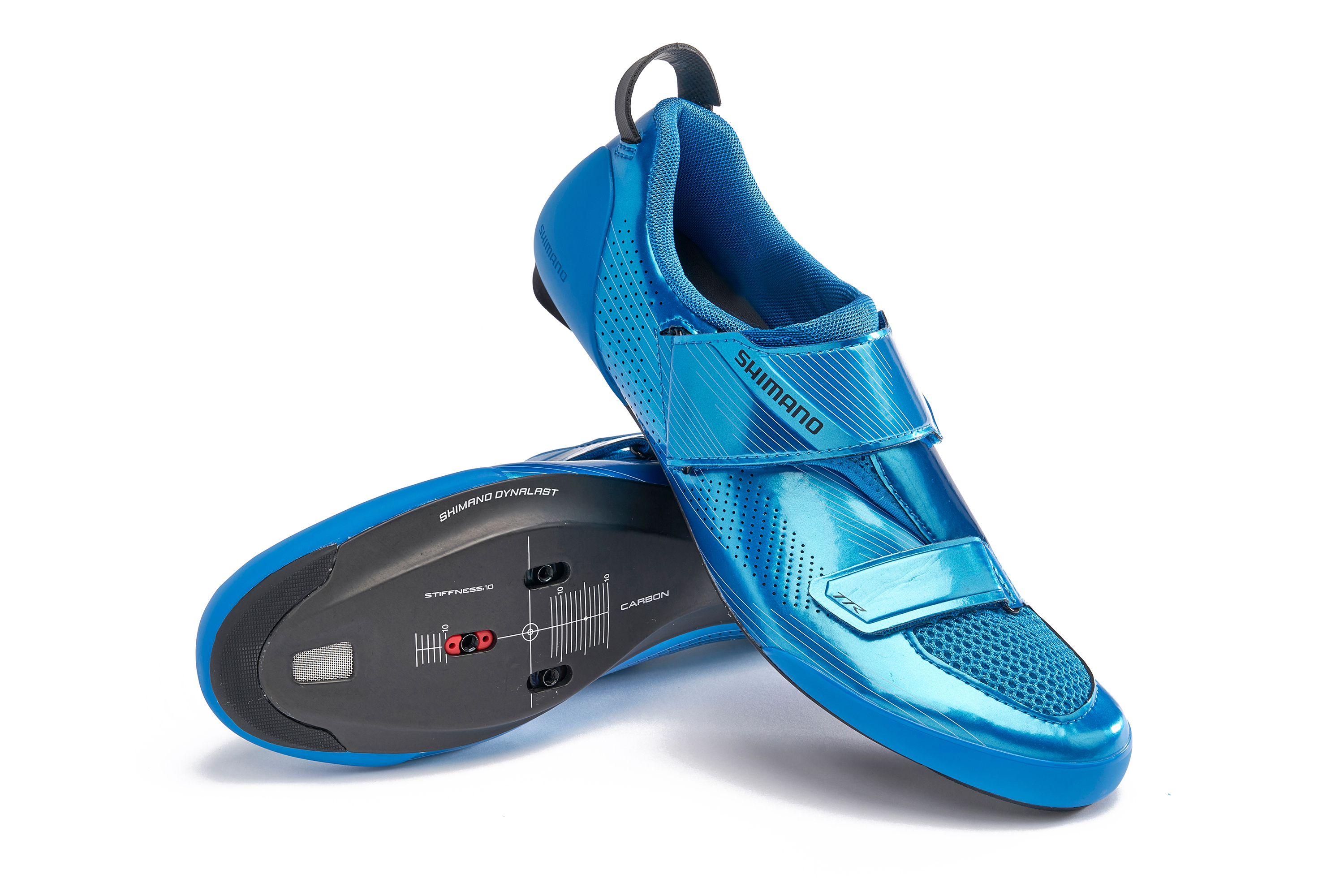
- £199.99 / $260
If you like the eye-catching metallic blue colourway then you can take advantage of the TR9’s supremely comfortable upper, quality carbon composite sole and nifty tri-specific features.
The straps close inwards, wrapping perfectly around the foot with no overhang, allowing you to get lots of tension, almost akin to a fully-fledged road shoe.
There’s plenty of venting throughout, and the breathable 3D mesh helps the shoe to dry extra quickly. A heavy-duty rubber heel tab at the back is a cut above the others on test, a welcome addition when you want to pull your shoes on quickly in T1.
220 Triathlon verdict
Show-stopping looks and performance. Score: 92%
Pros
- Look great
- Fantastic tri-specific features
Cons
- Not cheap
- Little else to fault
Fizik Transiro Hydra Aeroweave Carbon
Highly recommended triathlon bike shoe

- £289.99 / $299.99
The Fizik Transiro Hydra Aeroweave Carbon is a bit of a mouthful to say, but it has a lot going for it.
You get a heel bumper for jogging in transition, that all-important heel loop and a reverse Velcro strap closure.
The latter helps if you intend to leave your shoe clipped into your pedal before mounting it by keeping it away from the drivetrain.
The fit felt great for this tester, even if worn with socks in training, while the shoe feels exceptional without them too.
Airflow channels and a breathable upper help keep things cool, while the carbon outsole has the stiffest rating that Fizik offers and delivers excellent power transfer.
Read our full Fizik Transiro Hydra Aeroweave Carbon review for more.
220 Triathlon verdict
All-in-all, this is a fine triathlon bike shoe, but it does come at a cost. Score: 87%
Pros
- Comfortable with and without socks
- Excellent power transfer
Cons
- Tongue is quite long, so could catch on crank arm
- High price tag
Fizik R3 Transiro
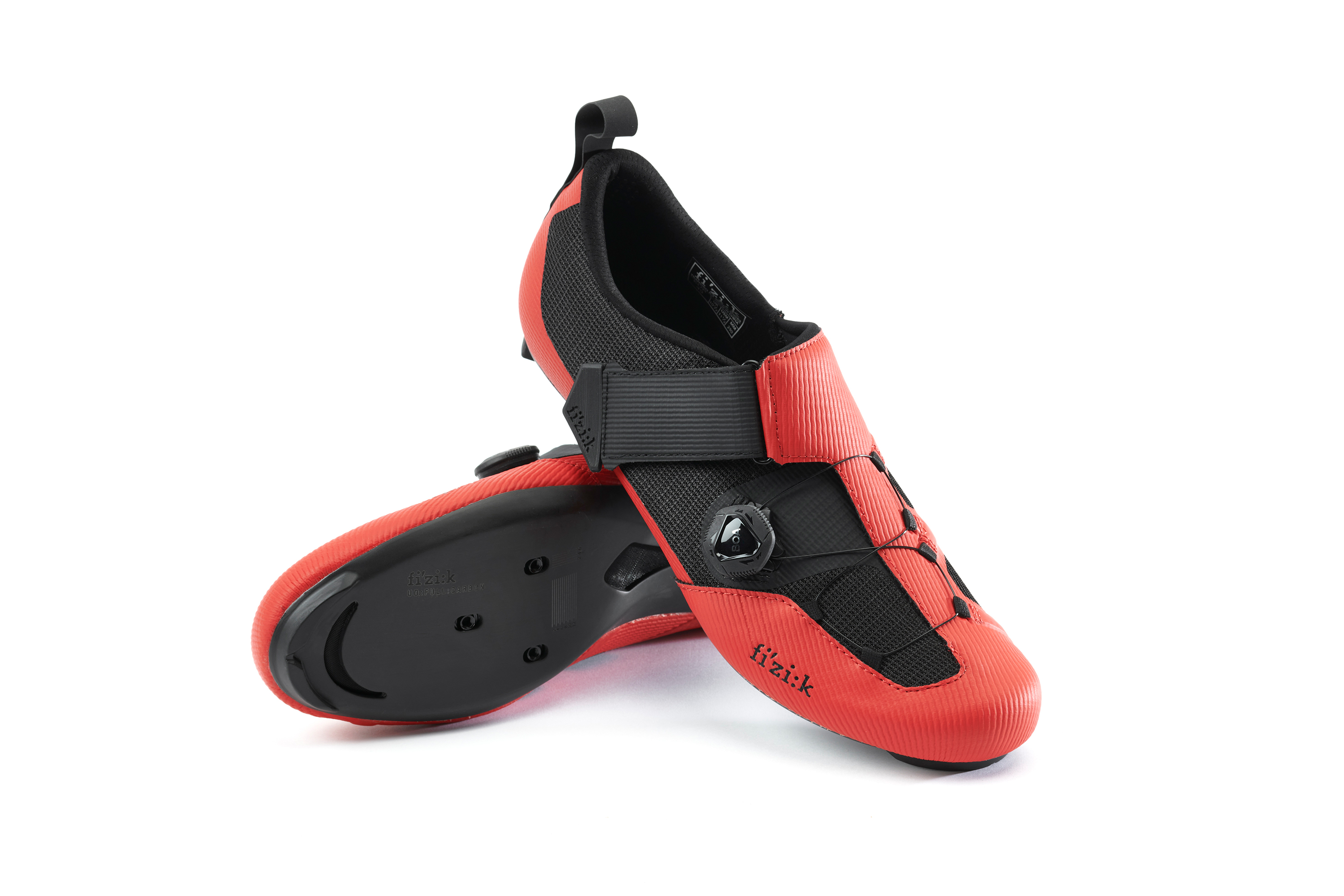
- £234.99 / $299.99
The R3 Transiro comes with a BOA dial, unidirectional carbon sole and polyurethane-laminated mesh upper. It’s one of the most expensive on test, but offers plenty of support in the upper and a super stiff sole.
The upper and strap are quite rigid, meaning the shoe doesn’t open as wide as Shimano’s TR9 and Scott’s Road Sprint, but a quick T1 is doable with practice.
There’s plenty of ventilation and mesh across the upper for quick-drying and breathability on hot days, and a large heel tab at the rear helps with transition. It isn’t the lightest though, at 300g per shoe.
220 Triathlon verdict
Stiff and secure shoe with a big ticket price. Score: 82%
Pros
- Lots of support and great stiff sole
- Decent ventilation
Cons
- Little on the heavy side
- Rigid upper
DMT KT1 Tri Shoes
Best triathlon bike shoe for breathability

- £249.99 / $374.99
Combine the KT1’s carbon sole with the knitted upper and you get a 240g shoe (EU44.5) that’s impressively light yet plenty stiff enough for triathlon.
The lightness doesn’t equal a lack of support, as the upper hugs your foot tightly.
The form-fitting construction means a single BOA dial is plenty for tightening the shoe, but a lack of straps means it’s a bit trickier to get on at speed, so we see this as more of a long-course shoe.
The upper dries quickly, making the KT1 among the most breathable and comfortable shoes we’ve ever tested. An excellent choice.
Read our full DMT KT1 Tri review for more.
220 Triathlon verdict
Superbly breathable and comfy high-end shoe. Score: 90%
Pros
- Super breathable
- Incredibly light, yet stiff too
Cons
- Precious seconds lost tweaking fit in T1
- Eye-watering price
Mavic Ultimate Tri
- Buy now from Sigma Sports (£399.99)
- £385 / $404
Mavic’s top-of-the-range Ultimate Tri has a price tag befitting of its name, promising cutting-edge materials and superior performance to justify it.
The upper is a polyamide and Kevlar weave with strategic vents for extra airflow, and the low stack height with a super stiff carbon sole should lead to maximum power transfer.
There’s nothing overcomplicated with the closure system, consisting of one sturdy strap on each shoe, and that’s fine by us.
You can get plenty of tension, it’s easy to get on and off aided by a pull tab, and the strap can be cut to your preference.
A weight of just 210g per shoe paired with the superbly breathable upper means we forgot we were wearing these shoes, and the heel cup has some extra padding to keep your foot in place.
This is a wonderfully stiff and breathable triathlon shoe for any distance, but the price will be hard to justify for many of us.
220 Triathlon verdict
Phenomenal triathlon shoe that comes with a steep price. Score: 81%
Pros
- Excellent power transfer
- Incredibly lightweight
Cons
- Almost £400!
- Did we mention the price?
Sidi Tri-Sixty
- Buy now from Saddleback (£360)
- £360
Sidi’s latest top-level triathlon shoe features the Italian brand’s Tecno-3 push dial system, promising quick transitions and superior tension along the whole length of the foot.
For the price tag we expected great things, and the Tri-Sixty mostly delivers with a supremely stiff carbon sole, great quality construction and plenty of comfort.
Sidi’s TechPro mesh is very breathable, and there’s some nice extra padding over the dial system to protect the midfoot.
While the closure system allows you to accurately tighten the shoes, with impressive levels of tension indistinguishable from road shoes, it did take us a few goes to master getting them off.
You first push the button, then click at the top and wind back… which could be too complicated for shorter course triathlon, when you want to spend as little time fiddling with your shoes as possible.
For long-course, where these milliseconds matter less, the Tri-Sixty is fantastic if you can afford it.
220 Triathlon verdict
Ideal for long course, but perhaps a little over-engineered. Score: 78%
Pros
- Excellent carbon sole
- Very comfortable
Cons
- Tricky tensioning system
- Another lofty price tag
Mavic Cosmic Elite Tri
Buy now from Sigma Sports (£165)
- £165 / $173
The Cosmic Elite Tri is less than half the price of Mavic’s top-end tri shoe, yet delivers performance that will be perfectly adequate for the vast majority of us.
The shoe is the same comfortable shape, the closure system is identical and you get a nice big pull tab for fast transitions.
What’s different is the Energy Comp outsole, which is more forgiving than the full carbon version, and the upper, which forgoes the fancy polyamide/Kevlar upper on the ultimate for a beefier synthetic construction.
We found it wasn’t quite as breathable as uppers on most higher end triathlon shoes, but there is still plenty of venting to prevent your feet from getting too hot.
The Ortholite insole provides a comfortable bed for the foot, and the stack height is low enough that you feel connected to the bike and able to put out just as much power as if you were wearing shoes twice the price.
220 Triathlon verdict
Many features of Mavic’s top shoe for much less cash. Score: 86%
Pros
- Very good value for money
- Great tri-specific features
Cons
- Not as breathable as top-end shoes
- Outsole isn’t as stiff as full carbon options
Scott Road Sprint Tri Shoe
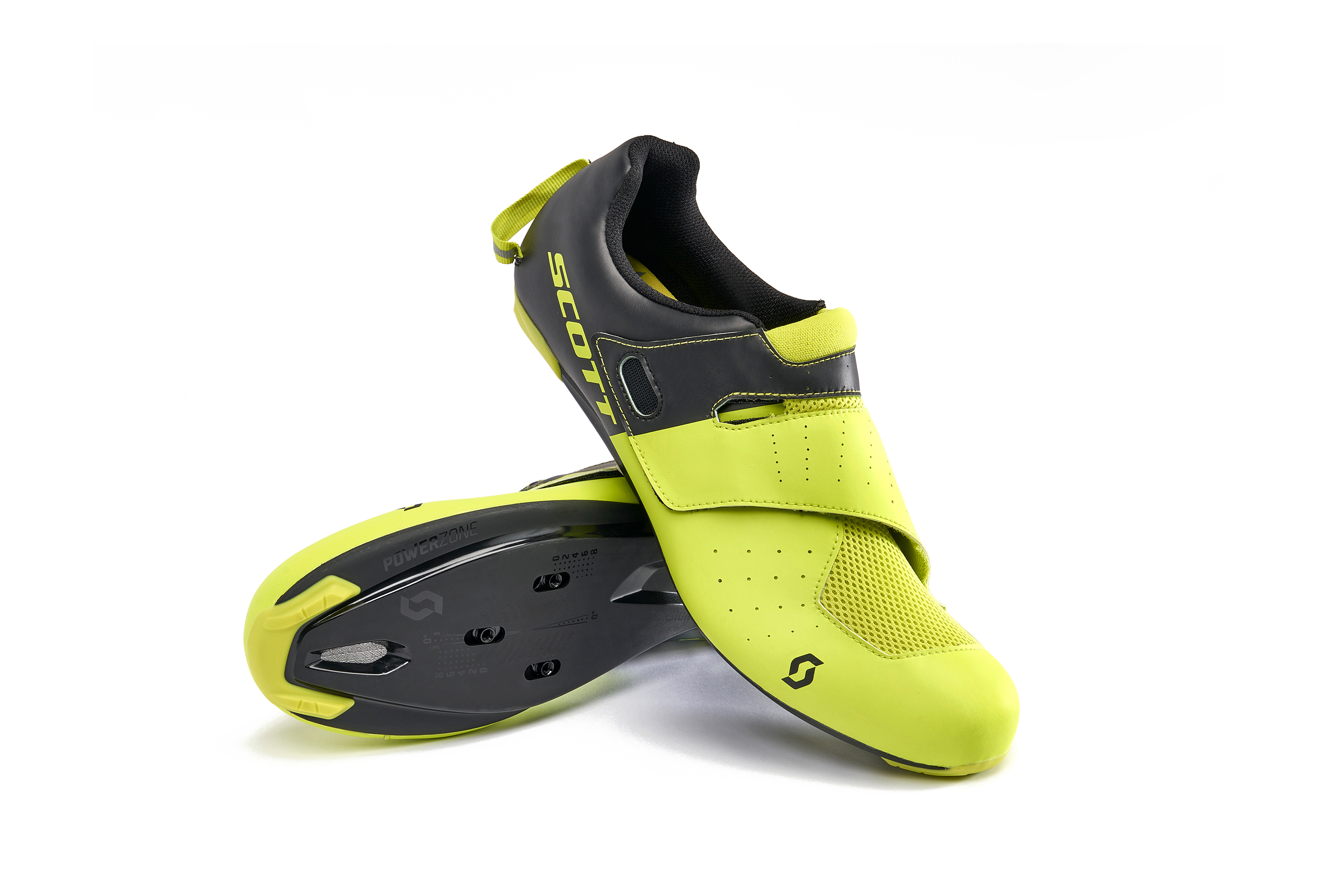
- £139.99
The Road Sprint Tri Shoe, weighing 296g, has one huge strap that makes it easy to get your foot in when mounting the bike in T1.
However, we had to pull the strap really tight to get the same tension as some other shoes on test. Scott’s ErgoLogic insole is a great addition, with three optional arch support pieces supplied depending on whether you have a high, medium or low arch.
Perforated parts of the upper and a large mesh section give you plenty of breathability and it’s quick-drying, while the nylon glass fibre composite sole provides reasonable stiffness without being too harsh.
220 Triathlon verdict
Fairly priced all-rounder built for fast transitions. Score: 85%
Pros
- Handy insole options
- Quick drying and breathable
Cons
- Tricky to get right level of tension
- Not particularly lightweight
Fizik Transiro Infinito R1 Knit
- Buy now from Sigma Sports (£323.99)

- £359.99 / $399.99
Knit weaves, more common in run shoes, have trickled into tri bike shoes with some success, as the Transiro Infinitos (294g) look and feel luxurious, especially barefoot. Concerns over heating proved unfounded.
Lack of hotspots goes for the closure system, too, the Boa mech working superbly for a swift transition and the most secure fit here without digging into your foot.
The stiffness of the full carbon outsole maximises your efforts, while further concerns about that knit weave suffering post-swim moisture were alleviated by the shoe’s waterproofing treatment.
220 Triathlon verdict
Pricey but you know where the money’s been spent. Score: 89%
Pros
- Feel luxuriously comforable
- Stiff full-carbon sole
Cons
- Far from budget-friendly
- Nothing else to note
Dhb Trinity
- Buy now from Evans Cycles (£40)

- £80 (UK only)
As you’d expect of Dhb, the Trinity is one of the most affordable (and heaviest, 314g) tri shoes on test.
That means there are price-based concessions, the most striking being its nylon outsole that can’t match the stiffness of carbon but, to be fair, is solid enough for newcomers.
But the main criticisms stem from the design. The first is the upper that’s simply not a great fit, with just too much tongue and upper material. The main strap’s not quite wide enough near the buckle, so is liable to slip out.
On the positive, foot entry’s comfy, the heel loop’s solid and there’s a neat transition hook.
220 Triathlon verdict
Good price but requires a few design tweaks. Score: 73%
Pros
- Great price
- Solid performance for the money
Cons
- Bland to look at
- The upper doesn’t fit all that well
Scott Road Tri Carbon
- £299.99 / $279.99
Designed for triathletes like Sebastien Kienle who are “up for the win”, Scott’s Road Tri Carbon has a single BOA IP1 dial at the rear of each shoe, which it says allowed for a sleeker, more aero shoe shape.
For those of us less likely to win anything, Scott promises superior comfort thanks to the ‘Wrap Fit’ upper that conforms to the shape of your foot, providing support with no pressure points.
A sole stiffness level of 9 (out of 10 on Scott’s own scale) coupled with the comfy upper makes for a shoe that allows you to put the power down and feel like your foot is well cushioned, ideal for long-course triathlon.
What lets it down is the rear BOA system, which does make the upper look better, but doesn’t provide a great deal of tension and makes the shoe very hard to get off.
It’s a struggle we could do without after 180km.
220 Triathlon verdict
Very comfortable, but rather difficult to get on and off. Score: 69%
Pros
- Comfortable upper
- Stiff sole offers great power transfer
Cons
- BOA system doesn’t tension well
- Shoe is hard to get off
Bont Riot TR+
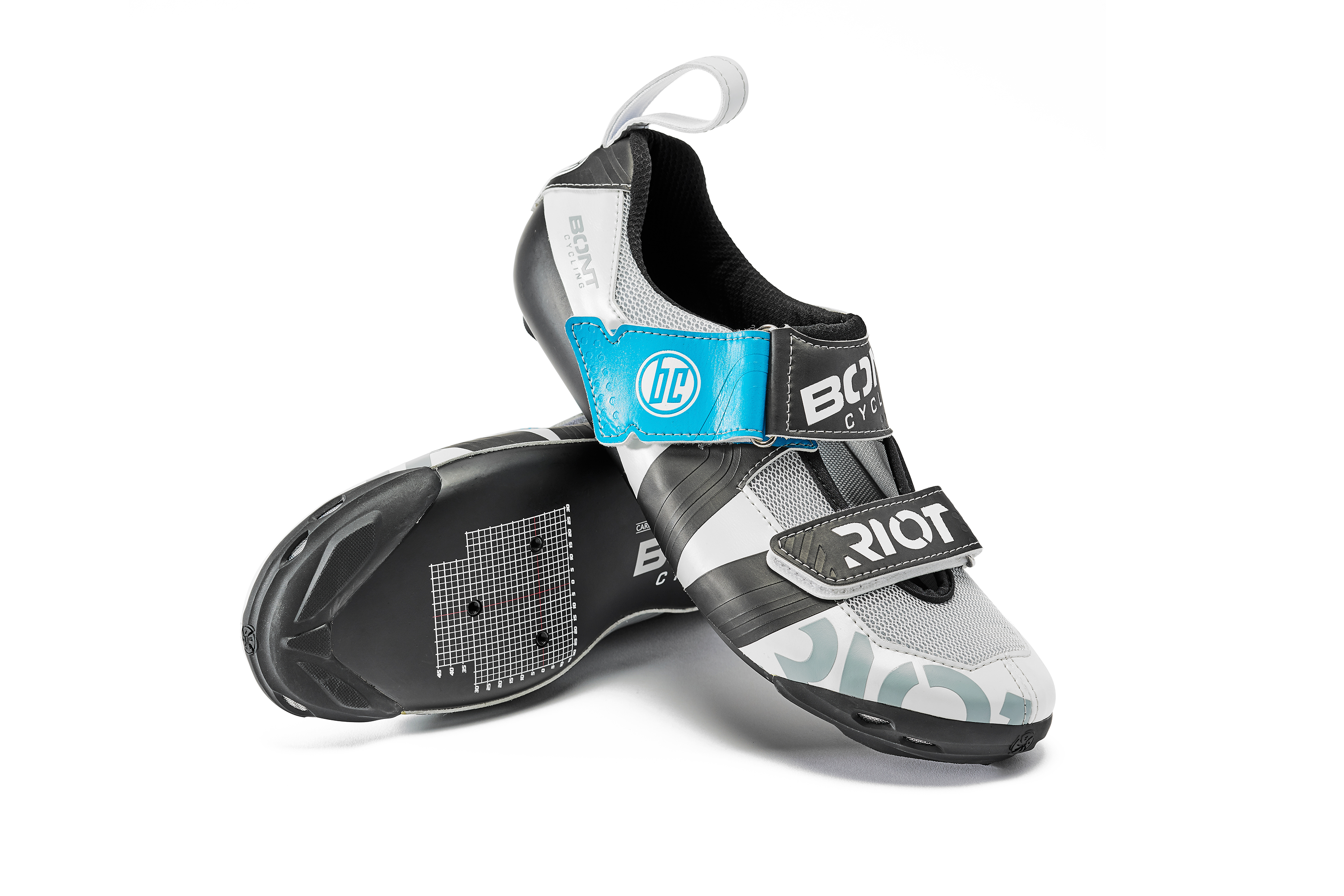
- £144.99
Compared to many here, at £145 Bont are almost giving away the Riot TR+ (306g). Yet this is the only shoe here that requires the extra outlay of an oven.
That’s because these are ‘the world’s only carbon-composite heat-mouldable entry-level triathlon shoe’.
Pop them in your oven for 10mins at 70°C. Remove, slip in and off you go. Okay, it’s more involved than that, but it’s worth it as they’re assured once moulded.
As for power transfer, the carbon-composite outsole isn’t as stiff as pure carbon, but you won’t notice a huge difference. Closure is sound, but the drainage holes could be larger.
220 Triathlon verdict
Bargain and bespoke; impressive stuff. Score: 86%
Pros
- Good value
- Decent closure sysem
Cons
- Not as stiff as pure carbon
- Drainage could be improved
Louis Garneau Tri X-Lite III

- £191.90
We like the devil in the detail and, for the Tri X-Lite III (250g), it’s a neat transition hook on the inner that you can attach to your bike for a swift T1.
Ease of entry’s heightened by a small strip of Velcro beneath the main strap to keep it open.
Of course, while a swift T1/2 is important, you still have many miles of riding. That’s where comfort and venting comes in.
Key features of both are the shoe’s Power Zone for better arch support, a comfy padded foot entry and, for venting, mesh upper strips and drainage holes on the outsole.
A solid carbon-composite outsole transitions power.
220 Triathlon verdict
A solid and reliable shoe that ticks many boxes. Score: 82%
Pros
- Good power transfer
- Lots of tri-friendly features
Cons
- Not the most exciting visually
- No standout flaws
Van Rysel Aptonia
- £79.99 / $119
Decathlon’s in-house bike brand Van Rysel has broken the mould with the upper on its wallet-friendly Aptonia, replacing straps with a zipper and adding an Atop dial on top for extra security.
The soft upper with mesh is very comfortable against the foot for sockless riding, and the fibreglass sole provides middling levels of stiffness.
Although we appreciate innovation, we struggled with the zipper, as we found it very difficult to zip and unzip the shoe during transition mock-ups.
Van Rysel says the shoe was tested in ‘several triathlons’, and we’re surprised that athletes giving feedback were able to operate the zipper at speed; we think a tough toggle on the zip could potentially fix this.
As far as transitions go, things are better at the rear, as the sizeable heel tab is easy to grab. Our test pair also came up quite small, so we’d advise sizing up, especially if you’re in between sizes.
220 Triathlon verdict
Affordable and comfy, but we’re unsure about the zips. Score: 70%
Pros
- Very good price
- Comfortable upper
Cons
- Zip proved difficult to use
- Sizing runs small
How we tested
The shoes tested here have been reviewed by experienced triathletes with decades of experience of kit testing.
To feature on this page, each shoe has gone through a sustained period of testing in both simulated and realistic race environments.
Every product has been tested with numerous rides, which have begun with wet or damp feet, as you would have in a race situation.
You can see our full testing criteria further down this page.
Ratings of 90% and over represent some of the best triathlon bike shoes that money can buy. Anything over 80% also comes very highly recommended, while a score of 70-80% means the shoes have a lot of pros, but also a few cons.
If a shoe scores below 70%, it still may be worth purchasing based on your needs and budget, but caution is advised to make sure it’s right for you.
Overall triathlon bike shoes verdict
For years, triathlon shoes were that by name only, as bike-shoe manufacturers stitched in a heel loop and proclaimed its multisport versatility.
Times have changed. As this speedy selection shows, evolution has seen various well-thought-out features to not only supercharge your transitions, but your bike leg, too.
Cue Fizik’s impressive Infinito R1 Knit, which has a knit weave that cranks up opulence as well as comfort. But it’s arguably the Boa ratchet mechanism that’s key to this shoe’s success.
In the past, this clamp system’s provided speed and security but caused hot spots. Now it’s lost weight, grown in comfort and is just great. Yet nearly £350 for shoes is jaw-dropping.
Those looking for lots of sole stiffness won’t be disappointed with Fizik’s R3 Transiro, with just the risk of a trickier transition and price, compared to our excellent top three, that prevented it from scoring even higher.
Bont’s Riot TR+ is far more affordable but still packed with goodness, yet its USP is more about fit than transition speed thanks to its heat-mouldable attribute. Heating your shoes to mould to your foot isn’t a new idea but it’s one that Bont’s executed perfectly.
The zip-closure system on Van Rysel’s Aptonia was a miss for us, although the comfort and very reasonable price meant it still scored above average.
We liked DMT’s KT1, a luxurious shoe that takes comfort to the next level with a highly-technical knitted construction.
Up there as one of the best on test is the Shimano TR9. This conspicuous and fairly-priced modern classic is now better than ever with improved ventilation, a secure fit and very comfortable insole to get you through anything up to 180km and beyond in style.
The right pair of triathlon bike shoes can make a significant difference in your performance and overall experience during a race.
After reviewing some of the top triathlon shoes on the market, we hope you have discovered some great options available to suit the needs of different athletes.
What to look for in the best triathlon bike shoes

Bike shoes are imperative for maximising power-transfer gains in a race, and a tri-specific pair will offer even more benefits.
Here’s what to look for in a good pair of triathlon-specific bike shoes…
Upper
No matter whether or not you don socks in between the swim and the bike legs, chances are you’re going to have some excess moisture sitting within your shoes.
As such, a ventilated upper is really important, as it’ll help your feet dry out, while it’ll also help you stay cool if racing in hot weather.
Look out for sections of mesh, knitted-style uppers or plenty of ventilation holes.
Bumpers
Tri-bike shoes often boast plastic heel and toe bumpers to ease running with your bike in transition and to protect the outsole from damage and scratches.
Straps
Many triathlon bike shoes use reverse main straps – running the opposite way to traditional road bike straps.
This is because they allow for a speedier exit and for easier adjustment on the move after T1.
The downside of tri straps is they can catch on the crank if they’re too long.
Some triathlon bike shoes may come specced with a Boa rachet,
Carbon sole
A carbon sole will save grammes and enhance the power transfer and pedalling efficiency, but will also add to the price of the shoe.
Heel loop
A heel tab should offer a speedier and easier foot entry in T1.
The loops need to be large enough to get your fingers into at speed, but not too sizeable to catch in anything or ruin the aesthetic appeal.
Shoe opening
Also think about how wide or supple the ankle opening is. A wider opening may make it easier to slide your foot into the shoe in a rush.
Looking for more? Check out our roundup of the best tri-suits.




























